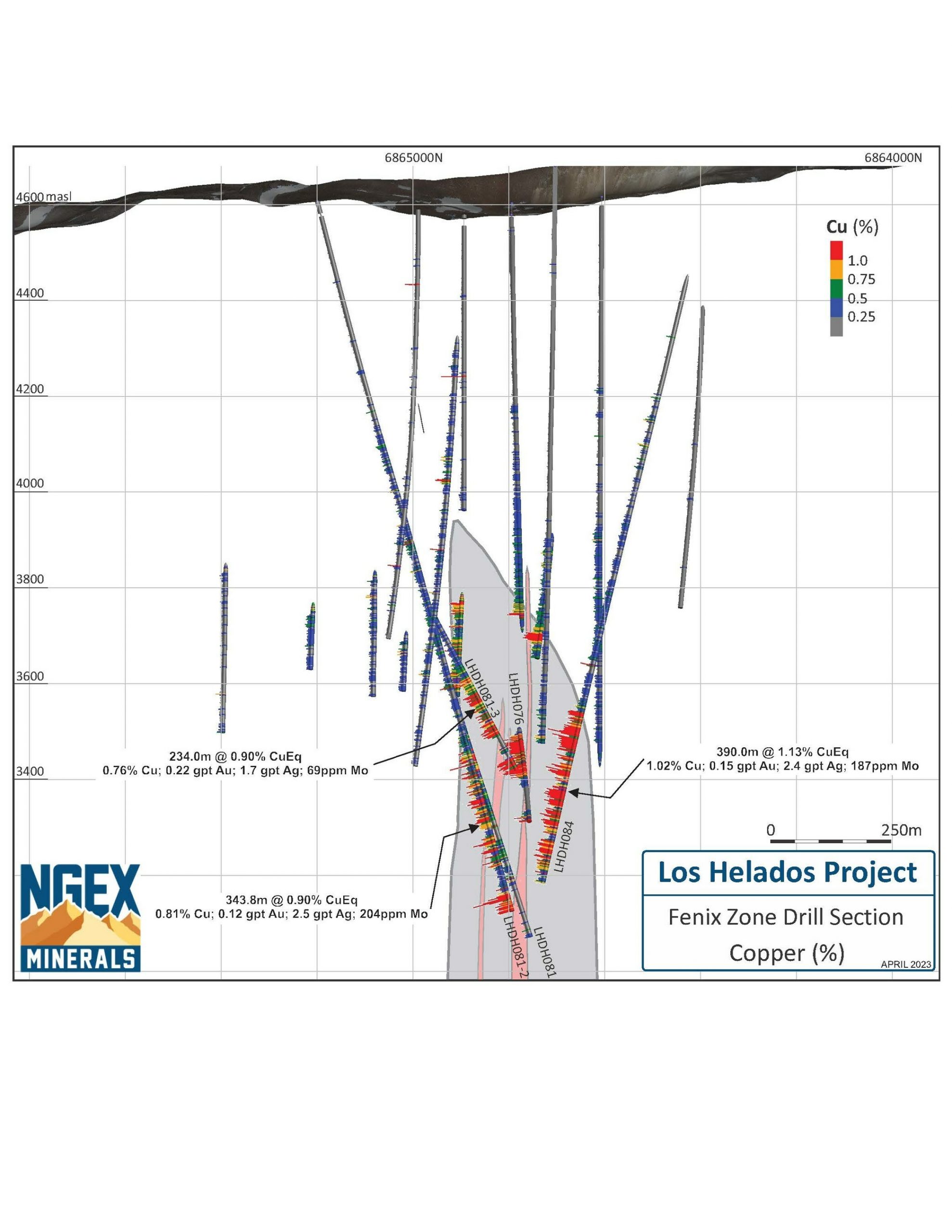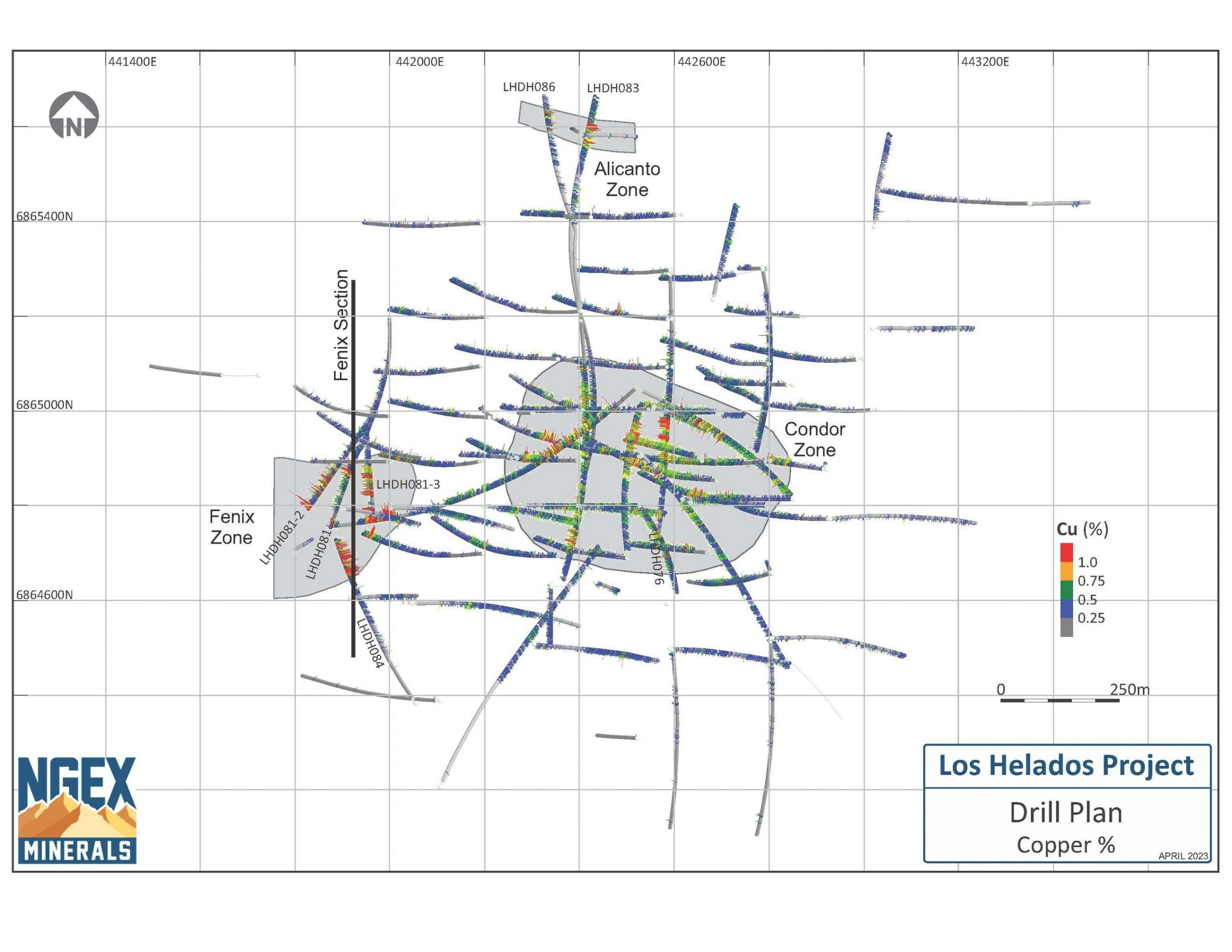
NGEx Minerals Ltd. (TSXV: NGEX) has released new assay findings from four drilled holes at the Los Helados copper-gold project situated in Region III, Chile. These results showcase some of the most exceptional grades ever encountered at Los Helados, especially with regards to molybdenum grades which surpass all previous intersections. They also provide evidence that the Fenix Zone is rapidly evolving into a second significant center of mineralization. The majority of the new drilling carried out in the Fenix and Alicanto Zones lies beyond the current Los Helados Mineral Resource, and both zones have potential for expansion in multiple directions.
Wojtek Wodzicki, President and CEO, commented in a press release: “The 2023 exploration program is shaping up to be the most successful and impactful in the Company’s history. Years of hard work and exploration experience are coming together to deliver a series of high impact discoveries. Last week we released high-grade results from the new Potro Cliffs discovery which is the fourth major system discovered in the Vicuña District. Today’s results from Los Helados, 9 kilometres to the north of Potro Cliffs, continue to confirm the Fenix and Alicanto Zones as significant new centres of high-grade mineralization. Both of these zones have considerable room to grow, and offer the potential for a meaningful expansion of the Los Helados resource. We are particularly encouraged by the copper and molybdenum grades of these new zones, which are significantly higher than the averages seen to date. This season’s drilling is proving the exploration adage that ‘Big systems tend to grow and deliver continued positive surprises.”

Highlights from the results are as follows:
- LHDH081-2: Fenix Zone:
- 343.8m at 0.90% CuEq, including 63.8m at 1.25% CuEq
- LHDH081-3: Fenix Zone:
- 234.0m at 0.90% CuEq, including 28.0m at 1.49% CuEq
- LHDH084: Fenix Zone:
- 390.0m at 1.13% CuEq
- LHDH086: Alicanto Zone:
- 104.0m at 0.69% CuEq
Composited intervals are shown in the table below. Note molybdenum (Mo) grades are not included in the CuEq calculation:
|
Hole ID |
From |
To |
Length (m) |
Cu % |
Au g/t |
Ag g/t |
CuEq % |
Mo ppm |
Zone* |
|
LHDH081-2 |
770.7 |
1549.8 |
779.1 |
0.54 |
0.10 |
2.0 |
0.61 |
121 |
Fenix |
|
incl |
1206.0 |
1549.8 |
343.8 |
0.81 |
0.12 |
2.5 |
0.90 |
204 |
|
|
incl |
1486.0 |
1549.8 |
63.8 |
1.14 |
0.14 |
3.6 |
1.25 |
741 |
|
|
LHDH81-3 |
814.0 |
1266.0 |
452.0 |
0.54 |
0.15 |
1.3 |
0.64 |
57 |
Fenix |
|
incl |
1032.0 |
1266.0 |
234.0 |
0.76 |
0.22 |
1.7 |
0.90 |
69 |
|
|
incl |
1032.0 |
1186.0 |
154.0 |
0.85 |
0.25 |
1.8 |
1.02 |
80 |
|
|
incl |
1238.0 |
1266.0 |
28.0 |
1.25 |
0.36 |
2.6 |
1.49 |
91 |
|
|
LHDH084 |
728.0 |
1500.0 |
772.0 |
0.67 |
0.11 |
1.7 |
0.74 |
119 |
Fenix |
|
incl |
1110.0 |
1500.0 |
390.0 |
1.02 |
0.15 |
2.4 |
1.13 |
187 |
|
|
LHDH086 |
938.0 |
1042.0 |
104.0 |
0.60 |
0.14 |
2.2 |
0.69 |
48 |
Alicanto |
|
incl |
998.0 |
1042.0 |
44.0 |
0.75 |
0.22 |
2.7 |
0.90 |
50 |
|
Mineralized zones within the Los Helados deposit are bulk porphyry-style zones and drilled widths are interpreted to be essentially true widths.
|
|
Copper Equivalent (CuEq) for drill intersections is calculated based on US$ 3.50/lb Cu, US$ 1,700/oz Au and US$ 20/oz Ag, with metallurgical recoveries of 88% for copper, 76% for gold and 60% for silver based on a comprehensive program of metallurgical testwork. The formula is: CuEq % = Cu % + (0.6117 * Au g/t) + (0.0057 * Ag g/t). |
LHDH081-2 was a daughter hole kicked off LHDH081 at a depth of 780.0m and angled towards the southwest. It was drilled to a final depth of 1,549.8m, intersecting the Fenix Zone between 35m and 90m to the west of LHDH081. The zone remains open to the west of this hole.
The Fenix Zone was intersected over a 343.8m interval from 1,206.0m to 1,549.8m and consists of a clast-supported hydrothermal breccia with a matrix composed of anhydrite, chalcopyrite, quartz and biotite. The average grade of this interval is 0.81% Cu, 0.12 g/t Au and 204ppm Mo which is considerably higher than the Los Helados deposit average.
The hole ended due to rig capacity in high-grade mineralization, with the final 20m averaging 1.36% CuEq (1.27% Cu, 0.11 g/t Au, 3.1 g/t Ag) plus 1540ppm Mo. Note that Mo is not currently included in the CuEq calculation.
LHDH081-3 was kicked off hole LHDH081-2 at a depth of 786.6m and angled towards the south to investigate the gap between holes LHDH081 and LHDH076. The hole encountered the Fenix Zone at a depth of 1,032.0m and drilled it to a final depth of 1,266.0m resulting in a partial intersection of 234.0m at an average grade of 0.76% Cu and 0.22 g/t Au. The hole was terminated due to technical complications on the part of the drill contractor.
The Fenix Zone in this hole was split by a low-grade porphyry dyke from 1,186.0m to 1,238.0m (52m) resulting in dilution to the overall intersection. This dyke was also intersected in holes LHDH076 and LHDH081 and its true width is estimated at 20-25m, indicating that it has a disproportionate impact on the overall grade of the intervals due to the angle of intersection with the drill hole.
LHDH084 was drilled from south to north across the Fenix Zone in the opposite direction from the LHDH081 series holes. The hole terminated in high-grade mineralization due to rig capacity at 1,500.0m, resulting in a partial Fenix Zone intersection of 390.0m grading 1.02% Cu, 0.15 g/t Au and 187ppm Mo.
The southern contact of the Fenix Zone was intersected at a depth of 1,110.0m which puts it 250m due south of the northern contact as intersected in hole LHDH081, establishing a minimum horizontal width for the zone. This hole ended 100m to the southeast of the end of LHDH081-2.
LHDH086 intersected the Alicanto Zone from 938.0m to 1,042.0m and returned 0.60% Cu and 0.14 g/t Au, including a higher-grade interval of 44.0m with 0.75% Cu and 0.22 g/t Au. This intersection is 60m to the west of the discovery hole, LHDH078, and the zone remains open in several directions beyond it.
Los Helados contains at least three distinct high-grade zones hosted within well-defined structural corridors that cross cut the large breccia body that hosts the deposit; the Alicanto Zone, the Condor Zone, and the Fenix Zone.
The current drilling program is focused on defining the geometry and size of the Alicanto and Fenix Zones. Holes currently completed with assays pending, or in progress are outlined below:
LHDH085: Drilling from north to south to intersect the Fenix Zone 140m east of LHDH076. Complete, assays pending.
LHDH086-1: Target 100m step-out to the east of LHDH078 on the Alicanto Zone. Complete, assays pending.
LHDH086-2: Target 100m step-out to the south of LHDH078 on the Alicanto Zone. Complete, assays pending.
LHDH087: Target to west of LHDH081-2 and LHDH084 on the Fenix Zone. In progress.
LHDH088: Drilling from north to south, across the Fenix Zone between LHDH076 and LHDH084. In progress.
The final two holes of the program are underway, supported by a directional drilling crew from STYR SpA, a leading provider of Devico directional drilling technology. The Company has also completed a comprehensive geophysical program to assist in targeting higher grade mineralization including a 3D IP/Resistivity survey, a drone magnetics survey, and a magneto-telluric survey. Results are currently being processed and will help guide a comprehensive interpretation combined with the results of the current drilling program.



 Follow us on Twitter
Follow us on Twitter Become our facebook fan
Become our facebook fan










Comments are closed.